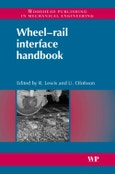Many of the engineering problems of particular importance to railways arise at interfaces and the safety-critical role of the wheel/rail interface is widely acknowledged. Better understanding of wheel/rail interfaces is therefore critical to improving the capacity, reliability and safety of the railway system.
Wheel-rail interface handbook is a one-stop reference for railway engineering practitioners and academic researchers. Part one provides the fundamentals of contact mechanics, wear, fatigue and lubrication as well as state-of-the-art research and emerging technologies related to the wheel/rail interface and its management. Part two offers an overview of industrial practice from several different regions of the world, thereby providing an invaluable international perspective with practitioners' experience of managing the wheel/rail interface in a variety of environments and circumstances.
This comprehensive volume will enable practising railway engineers, in whatever discipline of railway engineering - infrastructure, vehicle design and safety, and so on - to enhance their understanding of wheel/rail issues, which have a major influence on the running of a reliable, efficient and safe railway.
Please Note: This is an On Demand product, delivery may take up to 11 working days after payment has been received.








